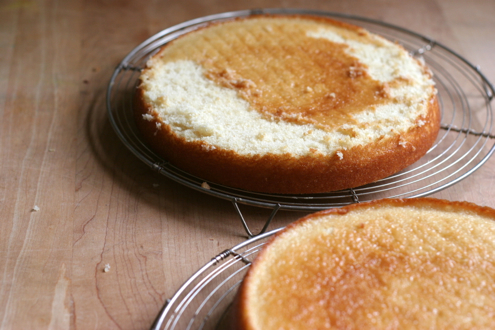My brother has said that I eat like a trucker, and when it comes to this particular sandwich that is probably accurate…
Even though I made them on Saturday night for fun, and even though Alistair’s birthday was only two days later, he still begged for banh mi for his birthday. As I like to be obliging about birthday dinner, and because banh mi are definitely high on my list of most delicious foods, I didn’t need any convincing to make them again. I would happily eat banh mi three times a week! So we had sticky pork banh mi two times in three days.
You might ask (especially if you live in Seattle) why would anyone make banh mi when you can get quite a decent one in the ID for $3? Yes, banh mi are practically a dime a dozen and yes, almost anyone I ask has their very favorite banh mi spot, but it doesn’t matter. I still love to make these little sandwiches at home. Homemade, the daikon and carrot pickle is tangier and crunchier, the meat more tender and caramelized, warm from the grill with glistening charred and sticky edges, and the herbs and greens are so crisp it might seem they are speaking directly to you in Vietnamese. Also, since nobody expects homemade banh mi – they’re such a takeout item – I love to surprise people by making my own.
 Caramelized Pork Banh Mi serves 4 generously
Caramelized Pork Banh Mi serves 4 generously
Caramelized pork
- (2) 3/4 lb pork tenderloins, sliced to 1/4″ thick on the diagonal
- 1/4 c. sugar
- 1/2 c. water
- 4-5 tbsp warm water
- 2 tsp Nước chấm (fish sauce)
- 2 tsp soy sauce
- 2 plump shallots, chopped and mashed in a mortar and pestle, or minced fine
- In a small heavy duty saucepan, combine the water and sugar over medium high heat. Simmer for about 15 minutes, or until the syrup has caramelized and is the color of an old penny – a rich deep reddish brown, not burnt though. You’ll know by the scent.
- Add 4 or 5 tbsp warm water – stand back a little! It will spatter and spit. Set aside to cool.
- When cool, put the caramel in a medium sized bowl and add the Nước chấm, soy and shallots.
- Start the grill.
- 20 minutes before you plan to start grilling the meat, toss the pork in the marinade and leave on the counter.
- Over hot coals or a with the gas set on high, grill the pork for 2 minutes on each side. As the slices come off the grill, stack them on a warm platter.
Daikon and Carrot Pickle
- 1 fat daikon radish, peeled and trimmed
- 2-3 medium carrots, peeled and trimmed
- 1/2 cup + 2 tsp sugar
- 1 tsp salt
- 1 1/4 c. white vinegar
- 1 c. warm tap water
- If you love to julienne vegetables, go for it and cut the daikon and carrot into 3/32″ matchsticks. I used to do that. Now I use the fat grater attachment on my food processor.
- Put the julienned or grated daikon and carrot in a colander and set it in the sink. Toss the carrot and daikon with 2 tsp of sugar and 1 tsp of salt. Let them sit for 10 or 15 minutes. Then rinse and shake the excess water out.
- Dissolve the sugar in the warm tap water and add the vinegar. Toss in the rinsed carrot and daikon and refrigerate until ready to use. This will keep covered in your fridge for a week.
- mayonnaise
- Two good handfuls of washed cilantro leaves
- shredded romaine
- sliced green chili – jalapeño or serrano
- 2 crisp baguettes (not too chewy!!), sliced into 6 -8″ lengths on the diagonal
- Slice the baguette down the length to make a long sandwich.
- Spread the bread with mayonnaise.
- In this order, stack sliced pork, romaine, carrot-daikon pickle, cilantro and sliced chili. They’re done!














































